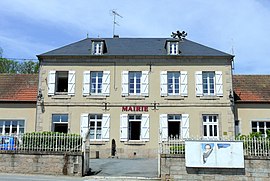Clugnat
Clugnat | |
|---|---|
 The town hall in Clugnat | |
| Coordinates: 46°18′33″N 2°07′09″E / 46.3092°N 2.1192°E | |
| Country | France |
| Region | Nouvelle-Aquitaine |
| Department | Creuse |
| Arrondissement | Aubusson |
| Canton | Boussac |
| Intercommunality | CC Creuse Confluence |
| Government | |
| • Mayor (2020–2026) | Yves Thomazon[1] |
Area 1 | 42.42 km2 (16.38 sq mi) |
| Population (2022)[2] | 653 |
| • Density | 15/km2 (40/sq mi) |
| Time zone | UTC+01:00 (CET) |
| • Summer (DST) | UTC+02:00 (CEST) |
| INSEE/Postal code | 23064 /23270 |
| Elevation | 287–537 m (942–1,762 ft) (avg. 330 m or 1,080 ft) |
| 1 French Land Register data, which excludes lakes, ponds, glaciers > 1 km2 (0.386 sq mi or 247 acres) and river estuaries. | |
Clugnat (French pronunciation: [klyɲa]; Occitan: Clunhac) is a commune in the Creuse department in the Nouvelle-Aquitaine region in central France.
Geography
An area of forestry and farming comprising the village and several hamlets, situated in the valleys of the Petite Creuse and the Verraux rivers, some 15 miles (24 km) northeast of Guéret at the junction of the D14, D11 and the D68 roads.
Population
| Year | Pop. | ±% |
|---|---|---|
| 1962 | 828 | — |
| 1968 | 916 | +10.6% |
| 1975 | 836 | −8.7% |
| 1982 | 809 | −3.2% |
| 1990 | 752 | −7.0% |
| 1999 | 687 | −8.6% |
| 2008 | 686 | −0.1% |
Sights
- The church of St. Martial, dating from the twelfth century.
- The modern chapel of St. John.
- The remains of the château de Bâtisse.
- An unusual war memorial.
See also
References
- ^ "Répertoire national des élus: les maires". data.gouv.fr, Plateforme ouverte des données publiques françaises (in French). 9 August 2021.
- ^ "Populations de référence 2022" (in French). The National Institute of Statistics and Economic Studies. 19 December 2024.




